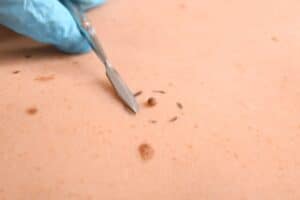Skin Tag
Removal
Mole & Skin Cancer
SKIN TAG REMOVAL
- Eyelids
- Axillae (armpits)
- Under the breasts
- Groin
- Upper chest
- Neck
- People who are overweight or obese, as there is an increase of skin folds and creases
- Pregnant women – most likely because of the hormones secreted.
- Individuals with diabetes
- People with the human papilloma virus (low-risk HPV 6 and 11)
- Illegal steroid use – they interfere with the body and muscles, causing the collagen fibers in the skin to bond, allowing skin tags to be formed
- A causal genetic component is thought to exist, i.e. susceptibility may be genetic. People with close family members who have skin tags are more likely to develop them themselves
As skin tags are usually harmless, people have them removed for aesthetic or cosmetic reasons. Sometimes large ones, especially in areas where they may rub against something, such as clothing, jewelry or skin, may be removed because the area becomes frequently irritated. An individual may have a large skin tag removed from their face or underarms in order to make shaving easier.
The following procedures may be used to remove skin tags: (These procedures should be performed only by a dermatologist or similarly trained medical professional, the likes at Main Street Cosmetic & Skin)
- Cauterization – the skin tag is burned off using electrolysis (heat is used to remove them)
- Cryosurgery – the skin tag is frozen off using a probe containing liquid nitrogen
- Ligation – the blood supply to the skin tag is interrupted
- Excision – the skin tag is removed with a scalpel (it is cut out)
- Skin tags on the eyelid – if the skin tag is very close to the eyelid margin, the procedure may have to be done by an ophthalmologist (eye specialist doctor)
Other options
- OTC (over-the-counter, no prescription required) solutions
- OTC solutions can be purchased at pharmacies which freeze the skin tag; it eventually falls off after 7 to 10 days. These medications are similar to wart-removal
- If the skin tag is small enough and suitable, it might come off by simply scratching it. However, it is best to have this done by one of our Doctors
- There is no evidence to support the theory that removing skin tags encourages more of them to develop
WHY CHOOSE US
Experienced Team
Our highly-skilled and experienced team of Therapists are trained in the latest technology and operate the safest machinery.
Safety & Technology
Using advanced technology and high-performance cosmeceutical skincare products our team highly-skilled team of Therapists is experienced in delivering best-in-class results.
Real Results
Our highly-trained team can help identify your concerns provide a tailored solution so that you can walk out looking and feeling your best.
Book a complimentary cosmetic consultation with our Expert online here, or call us direct on

SKIN TAG REMOVAL BLOG

Mole Removal: What is a skin tag and how do I get rid of it?
The first thing you do when you notice something foreign on your skin is to ask yourself three questions.

Mole Removal: Moles, freckles and skin tags
There are several skin lesions that are very common and benign (non-cancerous). These conditions include moles